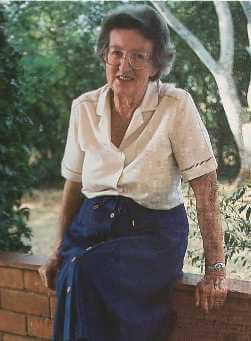In 1959, Mary discovered "Zinjanthropus" (Australopithecus boisei) from a fossil that managed to give worldwide fame to the Leakey family and was one of the hominids that split from the human lineage

Mary Leakey was born Mary Douglas Nicol on February 6, 1913. Her father, Erskine Nicol, was a popular landscape artist, and Mary spent most of her childhood in Europe, mainly in the Dordogne and Blaise Ezey, an area rich in prehistoric art and archaeological sites, subjects in which Mary was interested.
Her idyll was shattered in 1926, when her father, to whom she was particularly close, died and Mary and mother moved to London. Attempts to give her a conventional education failed, when the rebellious girl was expelled from two Catholic schools.
In 1930 she began taking courses in archeology and geology and worked in archaeological excavations as a scientific illustrator. She met Lewis Leakey in 1933 in Cambridge and their romance quickly blossomed. On his next expedition to Africa, she arranged to meet him there, returned home with him and returned with him again. After his wife Frida divorced him, they married in 1936. She returned to Kenya with Lewis the following year and in the following decades worked with him on many dig sites.
Mary Leakey's important discovery was the identification of the first skull of an extinct primate from the Miocene era called Proconsul. Mary worked primarily as an archaeologist rather than a physical anthropologist.
In 1959, Mary discovered "Zinjanthropus" (Australopithecus boisei) from a fossil that was able to give worldwide fame to the Leakey family. From the mid-sixties she lived almost most of the time in Old Dubai Channel, often alone, while Lewis worked on other projects, and also due to his dress-chasing. In 1974, she began excavations in the nearby area - Laetoli, and in 1976 her crew members discovered huge numbers of animal footprints that had been burned in the ash emitted by a volcano. In 1978 they found what would be her greatest discovery, footprints in nearby tracks left by two hominids walking on two.
In 1983, Mary retired from active field work, leaving the Old Bay Gorge for Nairobi, where she lived for almost 20 years. She died in 1996 at the age of 83. Although Lewis Leakey was a more charismatic and well-known figure, Mary became a famous scientist because of power. Although she never completed her academic degree, until the end of her life she received honorary degrees and many other awards. There is general agreement that Mary was a better scientist, much more rigorous and careful than the sometimes reckless Lewis.
The side branches of human evolution On the Freedom site, based on Prof. Yoel Rak's lecture
More of the topic in Hayadan:

3 תגובות
I wanted to say happy birthday to her. I am a very big fan of Mary Leakey. I really like all her discoveries. In short, you wanted to say happy birthday.
I wanted to say happy birthday and I'm a big fan of Mary Leakey, I really liked her discoveries in short happy birthday